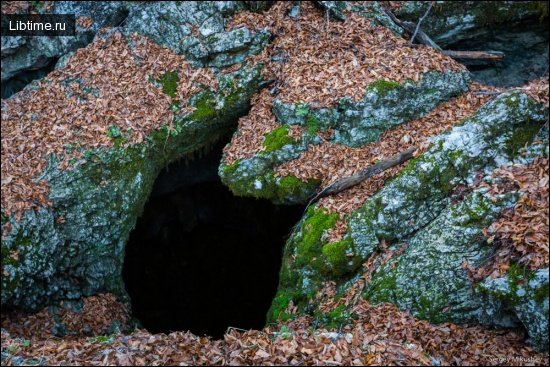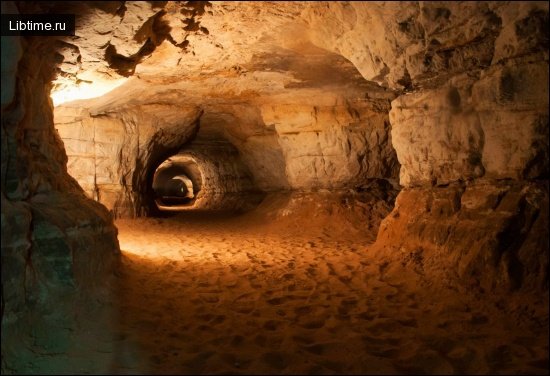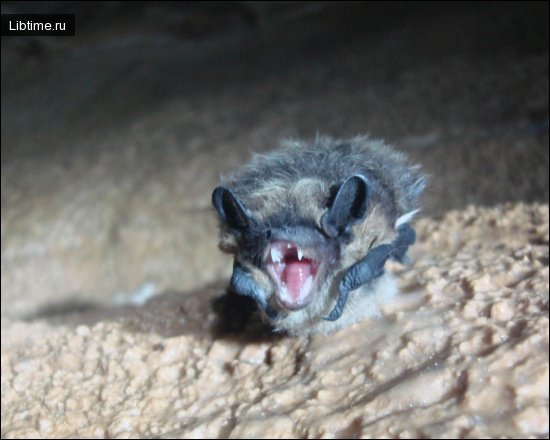Underground landscapes
Caves are complex underground natural complexes, special geographical underground landscapes (Semenov-Tyan-Shansky, 1928; Gvozdetsky, 1954; Gergedava, 1968, 1973) developed in the Earth's crust and limited by natural boundaries of underground cavities.
Underground natural complexes are closely connected with terrestrial ones. There is a constant exchange of mineral and organic substances between them, and karst water and air circulation in caves play an important role in this.
The study of underground landscapes and their individual components allows to restore the history of evolution of modern natural complexes with the greatest depth. 
Cave morphology
The set and peculiarity of components of underground landscapes are largely determined by the morphology of caves. A characteristic feature of the morphological structure of caves is the alternation of relatively narrow and low passages with wide and high grottoes.
The latter are usually confined to the areas of the greatest tectonic fracturing and to the places of development of chemically pure karst rocks. In some cases, the grottoes reach enormous sizes.
For example, the floor area of the grotto of the Georgian Speleologists of Anakopi cave is 10,635 m2. Morphological features of underground grottoes and their connecting passages are largely determined by the tectonic and lithogenetic fracturing of rocks, which determines the shape of the cross-section and the pattern of the planned arrangement of karst cavities.
The connection of the plan view of caves with the systems of tectonic fracturing is particularly well illustrated by the examples of Optimistic, Ozernaya, Kryvchenskaya, Khudugunskaya and many other caves.
Lithology and hydrological conditions often have a significant influence on the peculiarity of underground forms. Many caves are characterized by organ pipes, bag-shaped passages, ellipse-shaped depressions and carrs.
Organ pipes
Organ pipes, or chimneys, are vertical well-shaped cavities widened at the bottom and narrowed at the top. They are usually extensions of ponors developed at the bottom of sinkholes located on the surface of the karst massif.
The diameter of organ pipes varies from 0.2 to 6 m and more. They are almost always underlain by earth shoals. Organ pipes are especially widespread in the Kungur ice cave. There are 31 of them here. In some caves organ pipes cut through the whole roof, and daylight penetrates through them. 
The essence of mixing corrosion was first explained by Soviet researchers A. N. Buneev and F. F. Laptev, who proved a sharp increase in the aggressiveness of groundwater containing carbon dioxide in their mixing.
This process is important for the development of deep karst forms at the intersection of tectonic and lithogenetic fractures. Peculiar elliptical passages, bag-like passages and corrosive erosion cavities are associated with it.
The latter forms are noted, for example, in Navolishenskaya cave, located in the Khosta River valley in the Caucasus.
Karras as underground landscapes
Carrs on the ceiling and walls of caves are of great interest. They are connected with leaching of karst rocks by infiltration and condensation waters. Karrs have the form of cells or furrows separated by sharp scallops.
Original are bell-shaped karras formed in the ceiling of limestone caves. These forms, according to some researchers, are the result of the dissolving action of aggressive pressurized karst waters. 
Air and underground landscapes
The composition of cave air has not been studied sufficiently yet. However, studies have shown that the air of caves differs somewhat from atmospheric air. Thus, in most of the studied caves in the Crimea, the content of carbon dioxide was 0.3-0.5%, i.e. 10-15 times higher than in atmospheric air.
In some caves in the Crimea (mines Bezdonnaya, Khod Konem, Molodezhnaya and Profsoyuznaya) the concentration of carbon dioxide in the air reaches 5-7%. The main source of carbon dioxide in karst cavities are infiltration waters, which are enriched with carbon dioxide when seeping through the soil cover.
The increased content of carbon dioxide is also associated with oxidative processes (decomposition of organic matter) occurring in caves. In addition, in the air of karst cavities in the mountainous Crimea noted increased content of nitrogen, which can be explained by the underflow of dry jets of nitrogen-carbon dioxide gas, and sometimes nitrogen-methane composition from deep parts of the Earth in areas of major tectonic disturbances.
The air temperature of karst caves varies within significant limits, although low positive temperature prevails. The air temperature of caves depends on their morphological features, size, depth, position of the entrance to the prevailing winds and climatic conditions of the territory.
If the cave is small and air exchange in it is continuous, the air temperature of the cave almost does not differ from the outside air temperature. In blind sloping underground landscapes whose cavities are above the entrance, there are always high air temperatures, and if below, there are always low temperatures, because cold air stagnates here.
The air temperature of vertical cavities is significantly affected by the size of the entrance and their morphological structure. In wells with a wide entrance and a straight shaft the air is always colder than in cavities of the same depth, but having a narrow entrance and several ledges.
The influence of morphological structure on the temperature regime of underground cavities is well illustrated by the example of the Serpievskaya cave (170 m long), located on the western slope of the Southern Urals.
At an outside air temperature of 22.5° in the near part of the cave, characterized by some lowering of the floor, the air temperature of 2° was noted, in the middle (the lowest) - 2°, and in the far part, where the floor rises sharply upwards, 12°. Thus, at a distance of 85 m, due to morphological features of the cave structure, the air temperature changes by 14° (from -2 to 12°).
Large caves are usually divided into two parts according to the temperature regime. In the entrance part, the air temperature is subject to significant fluctuations during the year. The far parts of the cave are characterized by relatively constant air temperature in different seasons of the year.
The Kungur Ice Cave is interesting in this respect. In the nearest grottoes its temperature varies from 17 to 1°, which causes the appearance of ice formations that remain here all year round. In most of the cave there is a constant air temperature of 4.8-5°.
According to the peculiarities of the temperature regime, karst caves are subdivided into warm (air temperature in these caves is higher than the average annual temperature in this area), moderate (air temperature is equal to the average annual temperature) and cold (air temperature is lower than the average annual surface temperature).
Caves are characterized by high relative humidity, which is usually 98-100%. Air humidity is subject to seasonal fluctuations.
For example, in the Diamond Grotto of the Kungur Ice Cave the air humidity in the fall is only 67%, while in winter it rises to 95%. It has long been recognized that there is a constant exchange between underground and outdoor air.
Studies conducted in the Crimean caves, showed that the rate of air exchange in the underground cavities of the Crimea varies from once every five days (in caves with snow) to 157 times a day (in narrow crack-shaped mines), with an average intensity of air exchange for the entire main ridge of the Crimean Mountains is 14 times a day.
Consequently, the air during the day is renewed many times. The speed and direction of the air flow of caves are determined by the differences in the density of outdoor and underground air, as well as the peculiarities of the morphological structure of cavities.
An important role is also played by karst rivers, which entrain the air during inflation into underground cavities, and by the external wind. Horizontal karst caves are characterized by seasonal changes in the circulation of air flow. In winter, when the outside air temperature is much lower than the underground air temperature, there is a movement of cold air inside the cave.
At the same time warmer cave air is forced out of the cave through cracks and organ pipes. When it reaches the Earth's surface in the frost, it turns into ice crystals, forming a jet of "frost fog".
In the warm season, on the contrary, the cold underground air leaves the lower horizontal galleries to the outside, while through vertical cavities and cracks in the cave comes warmer outside air, which in the underground galleries is gradually cooled, determining the high humidity of the air, sometimes reaching 100%.
At condensation of water vapor is released a significant amount of heat, which causes an increase in the temperature of the air in the caves. The speed of the air flow is determined by the temperature difference between the outside air and the cave air.
In spring and fall, when the temperature of the outside and underground air is approximately the same, the air movement in the caves is greatly weakened, and sometimes for a short period of time (7-14 days) it stops altogether.
In the Kungur Ice Cave the air moves on average 182 days into the cave and about 170 days out of the cave. In mid-April and early October there is no air movement for 7-10 days.
Inclinedcaves are characterized by different conditions of air circulation. Inclined caves, the closed end of which is above the entrance, are warm. In summer, warm air moves into the cave and warms it, but in winter there is no air movement in the cave because colder denser air cannot rise up and displace the warmer cave air.
In contrast, sloping, bag-shaped caves going downward from the entrance are cold. In winter, when the cold air completely displaces the warmer air, they are severely hypothermic. In summer, air movement in them stops, as warm air cannot enter the cave.
Similar conditions are created in vertical caves - mines. Thus, the air movement in the cave, determined by the difference in the density of external and underground air, is determined by the peculiarities of the morphological structure of the cave.
We have considered only the most typical cases. Of course, there are many other variants. In large complexly constructed caves, separate parts can be characterized by their own, sharply different from the neighboring ones, type of circulation.
In this regard, dynamic and static microclimatic zones are distinguished in large caves on the basis of air dynamics. Along with seasonal fluctuations, daily fluctuations are also observed.
For example, the air flow velocity at the entrance to the Kungurskaya Cave in July at night is 2.2, and during the day - 5.1 m/sec, which is associated with changes in outdoor air temperature.
The airflow velocity in vertical caves is not high. Thus, in a small mine in the Crimea, its average speed, according to the data of V. N. Dublyansky and V. V. Ilyukhin (1971). V. Ilyukhin (1971), is only 0.006 m/sec. Thus, underground landscapes are very diverse.
Caves are subdivided into three main types according to the peculiarities of microclimate changes:
- dynamic (characterized by sharp changes in meteorological components within short time intervals),
- statodynamic,
- static (characterized by the constancy of climatic conditions over a long period of time).


